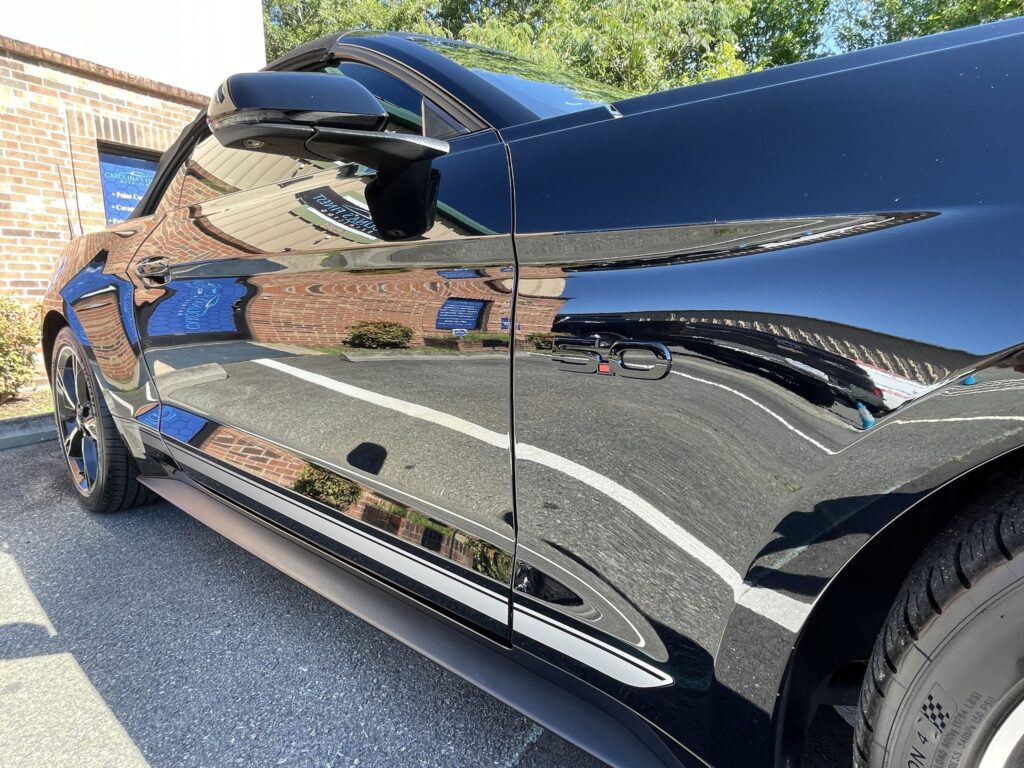Before diving into the application process, make sure your car’s surface is thoroughly cleaned and free from any imperfections that could hinder the paint protection film’s adhesion. However, one vital step often overlooked can make or break the entire process. Be sure to stay tuned to uncover the key factors that can greatly affect the longevity and effectiveness of your paint protection film application.

Key Takeaways
- Thoroughly clean the exterior and remove existing wax.
- Inspect for imperfections and contaminants.
- Lightly sand the surface for adhesion.
- Degrease with a high-quality degreaser.
- Ensure a smooth, clean, and primed surface.
Cleaning the Car Exterior
Before commencing the paint protection film application process, thoroughly clean the exterior of your car to ensure a smooth and flawless finish. Start by inspecting the surface for any imperfections or contaminants that may impact the film’s adhesion. Remove any existing wax from the car’s surface using a wax removal solution to secure proper bonding of the paint protection film.
Next, proceed to degrease the exterior of your car using a high-quality degreaser. This step is vital as it eliminates any grease, oil, or dirt that could impede the film from adhering correctly to the surface. Be thorough in this process, especially in areas prone to collecting dirt and grime, such as the lower panels and wheel wells.
After degreasing, prepare the surface for the paint protection film by lightly sanding it. This step helps create a rough texture, allowing the film to grip the surface securely. Use fine-grit sandpaper to gently roughen the clear coat without harming the paint. Make sure to clean the area again after sanding to eliminate any dust particles that may have settled.
Removing Any Surface Contaminants
Examine the car’s exterior surface meticulously to identify and remove any surface contaminants that could hinder the paint protection film application process. Ensuring a clean surface is vital for the film to adhere properly and provide top-notch protection for your car’s clear coat.
Follow these steps to eliminate any surface contaminants effectively:
- Surface Protection: Before applying the paint protection film, it’s crucial to make sure that the clear coat is free from any dirt, dust, or grime. Use a gentle automotive detergent or a specialized pre-cleaner to eradicate any contaminants that could impact the film’s adhesion.
- Film Adhesion: Residue from substances like tar, tree sap, or bug splatter can disrupt the film’s adhesion. Use a residue remover specifically formulated for automotive surfaces to eliminate these stubborn contaminants. Ensure thorough cleaning in areas prone to accumulation, such as the front bumper and hood.
- Inspect Thoroughly: Pay close attention to the entire surface of the car, including crevices and edges, where contaminants may lurk. Use appropriate lighting and feel the surface with your hands to detect any roughness or remaining debris that needs removal.
- Final Cleanse: After eliminating contaminants, give the car a final cleanse using a clean microfiber cloth and isopropyl alcohol to eradicate any remaining traces of contaminants or cleaning agents. This step is essential to achieving a smooth surface for the paint protection film application.

Ensuring a Smooth Surface
To achieve ideal paint protection film adhesion, ensuring a smooth surface on your car’s exterior is essential. Proper surface preparation is key to achieving this. Begin by thoroughly cleaning the surface to remove any dirt, grease, or residues. Once clean, inspect the surface for any imperfections such as scratches, dents, or uneven areas that could affect the film’s adhesion.
Sanding techniques play a pivotal role in achieving a smooth surface. Use a fine-grit sandpaper to gently sand down any imperfections, making sure not to sand too aggressively to avoid causing damage to the underlying paint. After sanding, wipe down the surface with a clean microfiber cloth to remove any sanding dust particles.
When considering paint protection film, it’s important to weigh its benefits and drawbacks. Paint protection film provides a durable layer of protection against road debris, scratches, and UV rays, helping to maintain the car’s finish. However, it can be prone to discoloration over time and may require professional installation for best results.
Preparing the Paint for Adhesion
Properly preparing the paint surface on your car is necessary to ensure the best adhesion of the paint protection film. To guarantee a successful application, follow these critical steps:
- Sanding Process: Begin by sanding the paint surface of your car. This step is important as it helps create a rough texture for the primer to adhere to, allowing for a strong bond between the paint and the protective film.
- Primer Application: After sanding, apply a high-quality primer specifically designed for automotive use. The primer serves as a foundation for the paint protection film, promoting adhesion and enhancing durability.
- Even Application: Make sure to apply the primer evenly across the sanded areas. An even coat is crucial to prevent any inconsistencies that could affect the adhesion of the protective film.
- Drying Time: Allow an ample amount of time for the primer to dry completely before proceeding with the paint protection film application. This ensures that the primer has fully bonded to the paint surface, providing a solid base for the film.
Final Inspection and Pre-Installation Checks
Before proceeding with the installation of the paint protection film, conduct a thorough final examination and complete all necessary pre-installation assessments to secure the best outcomes. Start by checking alignment to confirm the film will fit properly in the intended areas of your car. Make sure the surface is clean and free of any debris that could impact the film’s adhesion.

Next, meticulously examine the paintwork for any imperfections such as scratches, swirl marks, or existing damage. Addressing these issues beforehand will prevent them from being sealed in by the film, preserving the overall appearance of your vehicle.
Additionally, verify that the temperature and humidity levels in the installation area are within the suggested range to achieve ideal adhesion and curing of the film. Proper environmental conditions are essential for a successful application.
Take the time to review the manufacturer’s guidelines and recommendations for the specific paint protection film being used. Following these instructions will help secure a smooth and effective installation process.
Now that you’ve completed the necessary steps to prepare your car for paint protection film application, you’re all set to guarantee your vehicle stays looking sleek and protected for years to come. So go ahead, give your car the TLC it deserves, and watch it shine like a diamond in the rough. Remember, a little prep work goes a long way in preserving your prized possession!
